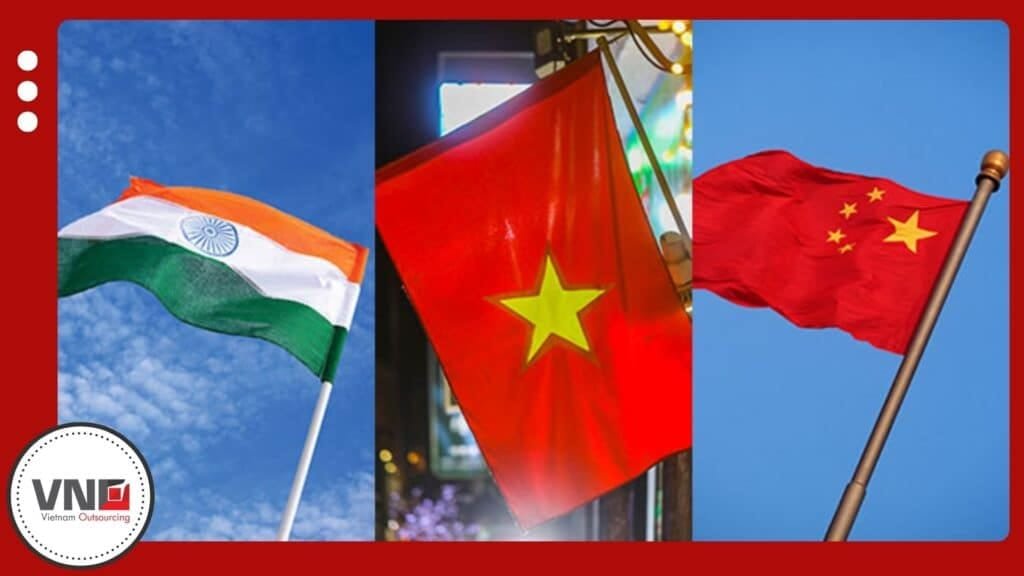Metal Fabrication Cost Comparison: Vietnam vs. China & India

Table of Contents
Introduction
Metal fabrication cost comparison is a critical factor for businesses in the U.S., Canada, UK, and EU looking to optimize their supply chain. Vietnam, China, and India have emerged as the top contenders for outsourced manufacturing, each offering distinct advantages. However, cost remains a crucial factor in the decision-making process.
This article provides a detailed metal fabrication cost comparison in Vietnam, China, and India, analyzing labor costs, infrastructure, trade policies, and overall competitiveness to help businesses make informed choices in 2025.
Labor Costs: Vietnam Offers the Most Competitive Workforce
Labor costs are one of the biggest expenses in metal fabrication, directly impacting the final product price. Over the years, China has seen increasing wages due to economic growth, while Vietnam and India continue to offer lower-cost alternatives.
Manufacturing Labor Costs per Hour (2025):
- China: $6.50
- India: $3.50
- Vietnam: $3.10
Vietnam provides a significant cost advantage, especially compared to China, where wages have more than tripled over the past 20 years. As China moves towards high-tech manufacturing, companies looking for labor-intensive metal fabrication find Vietnam a more cost-effective alternative.
India, while still a low-cost country, faces challenges such as inconsistent labor skills, infrastructure gaps, and productivity concerns, making Vietnam a more stable option for precision metal fabrication.
Manufacturing Competitiveness: Vietnam Rising as a Strong Contender
The overall cost of manufacturing extends beyond labor. Countries are ranked based on factors like raw material availability, ease of doing business, infrastructure, and government incentives.
Top Low-Cost Manufacturing Destinations (Global Rankings):
- India
- China
- Vietnam
Despite India being ranked first, businesses often prioritize quality and reliability over sheer cost-cutting. China’s established dominance in high-volume production remains strong, but Vietnam is rapidly closing the gap by investing in manufacturing capabilities, workforce training, and technology adoption.
Vietnam’s increasing competitiveness in CNC machining, welding, and metal forming makes it an attractive destination for businesses needing precision fabrication at a lower cost.
Infrastructure and Supply Chain: China Leads, But Vietnam Is Catching Up
China has spent decades building an extensive infrastructure network, supporting seamless global exports. However, rising costs, strict environmental regulations, and geopolitical tensions have made companies rethink their reliance on Chinese suppliers.
Vietnam, on the other hand, has rapidly modernized its logistics infrastructure, investing heavily in seaports, highways, and manufacturing zones.
Infrastructure Readiness & Supply Chain Strength:
- China: 1st place (Strongest global supply chain)
- Vietnam: 2nd place (Fastest-growing manufacturing hub)
- India: 3rd place (Still developing efficient supply chains)
Vietnam’s advantage lies in its proximity to China, allowing businesses to diversify supply chains without completely moving away from the existing Chinese supplier ecosystem. Many global firms are shifting partial operations to Vietnam while still sourcing components from China, creating a hybrid supply chain strategy.
Trade Policies and Market Access: Vietnam Benefits from Free Trade Agreements
Trade policies significantly impact import/export tariffs, taxes, and ease of doing business. Vietnam stands out due to its strong international trade agreements, particularly its involvement in the CPTPP (Comprehensive and Progressive Agreement for Trans-Pacific Partnership) and EVFTA (EU-Vietnam Free Trade Agreement).
U.S. & EU Trade Advantages by Country:
- Vietnam: Tariff reductions due to trade agreements with the U.S. & EU
- China: Subject to higher U.S. tariffs due to trade tensions
- India: Limited access to Western free trade agreements
Vietnam’s trade relationships help reduce costs for international buyers, making it a more attractive alternative to China. The ongoing U.S.-China trade war has also prompted companies to look for less politically sensitive suppliers, further driving interest in Vietnamese metal fabrication.
Vietnam vs. China vs. India: Key Cost & Performance Comparison
| Factor | Vietnam | China | India |
|---|---|---|---|
| Labor Costs (per hour) | $3.10 | $6.50 | $3.50 |
| Manufacturing Competitiveness | 3rd globally | 2nd globally | 1st globally |
| Infrastructure Readiness | Growing rapidly | Most developed | Developing |
| Export Logistics | Fast-growing | Strong global network | Developing |
| Trade Agreements (U.S. & EU benefits) | Strong (CPTPP, EVFTA) | Trade restrictions with the U.S. | Limited agreements |
| Government Support for Manufacturing | High (tax incentives) | Moderate (shifting focus to tech) | High (Make in India policy) |
| Overall Cost Efficiency | High | Moderate (rising costs) | High, but quality concerns |
Why Vietnam is the Best Choice for Metal Fabrication in 2025
For companies looking to outsource metal fabrication while maintaining cost efficiency, quality, and reliable supply chains, Vietnam is the top choice in 2025.
Key Advantages:
- Lower labor costs than China and India, making fabrication more affordable.
- Improved manufacturing competitiveness, rapidly catching up with global leaders.
- Strategic location for companies diversifying away from China while keeping supply chains intact.
- Strong trade agreements with the U.S. & EU, reducing import/export costs.
- Government incentives for foreign manufacturers, creating a business-friendly environment.
China remains suitable for large-scale, high-tech manufacturing, while India excels in domestic-focused production. However, Vietnam provides the best balance of affordability, quality, and international trade access, making it the ideal partner for metal fabrication outsourcing.
Metal fabrication cost comparison conclusion
The decision to outsource metal fabrication depends on cost, infrastructure, workforce quality, and trade policies. Vietnam, China, and India each have strengths, but for U.S. and EU-based businesses, Vietnam provides the most attractive mix of low costs, reliable exports, and manufacturing expertise.
For businesses seeking custom metal fabrication, CNC machining, welding, or sheet metal processing, Vietnam offers the best value proposition in 2025.

